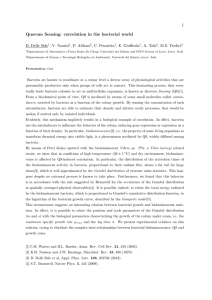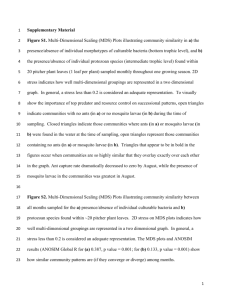IB Math Studies 2 Applications of Growth and Decay and Sample IB
advertisement
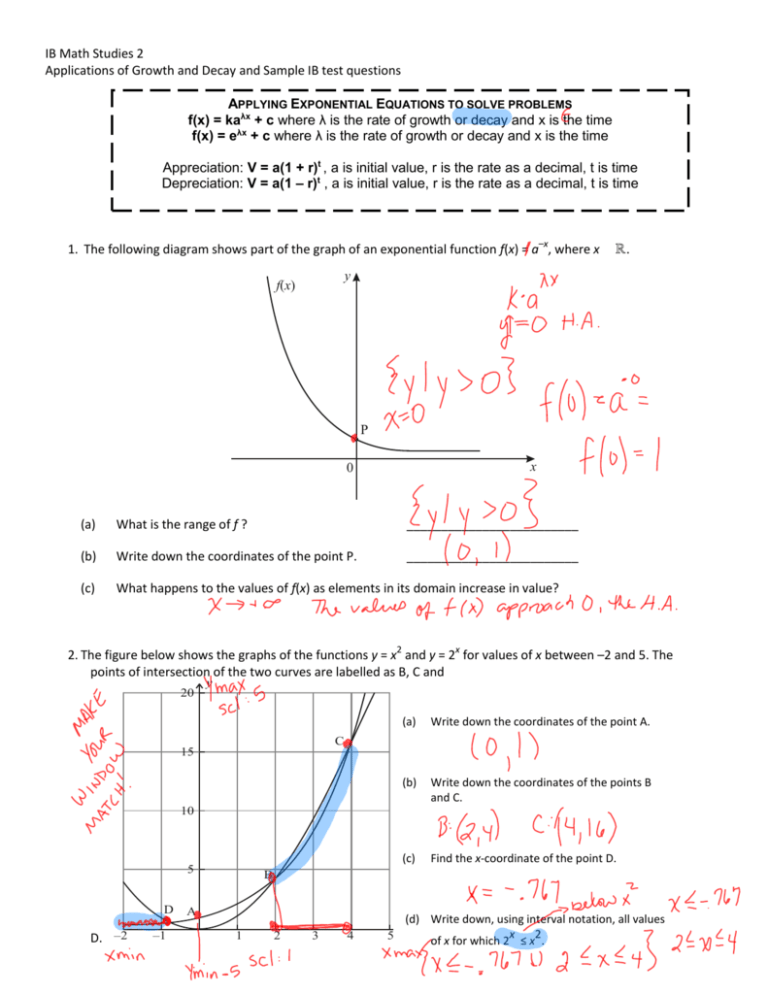
IB Math Studies 2 Applications of Growth and Decay and Sample IB test questions APPLYING EXPONENTIAL EQUATIONS TO SOLVE PROBLEMS f(x) = kaλx + c where λ is the rate of growth or decay and x is the time f(x) = eλx + c where λ is the rate of growth or decay and x is the time Appreciation: V = a(1 + r)t , a is initial value, r is the rate as a decimal, t is time Depreciation: V = a(1 – r)t , a is initial value, r is the rate as a decimal, t is time 1. The following diagram shows part of the graph of an exponential function f(x) = a–x, where x . y f(x) P x 0 (a) What is the range of f ? _________________________ (b) Write down the coordinates of the point P. _________________________ (c) What happens to the values of f(x) as elements in its domain increase in value? 2. The figure below shows the graphs of the functions y = x2 and y = 2x for values of x between –2 and 5. The points of intersection of the two curves are labelled as B, C and 20 y (a) Write down the coordinates of the point A. (b) Write down the coordinates of the points B and C. (c) Find the x-coordinate of the point D. C 15 10 5 D D. –2 –1 B A 1 2 3 4 5 (d) Write down, using interval notation, all values x x 2 of x for which 2 ≤ x . IB Math Studies 2 Applications of Growth and Decay and Sample IB test questions 3. The figure below shows the graphs of the functions f (x) = 2x + 0.5 and g (x) = 4 − x2 for values of x between –3 and 3. y f(x) 6 B 3 A –3 –2 –1 0 –3 3 x 2 g(x) (a) Write down the coordinates of the points A and B. ______________________ (b) Write down the set of values of x for which f (x)< g (x). ______________________ The following graph shows the temperature in degrees Celsius of Robert’s cup of coffee, t minutes after pouring it out. The equation of the cooling graph is f (t) =16 + 74 × 2.8−0.2t where f (t) is the temperature and t is the time in minutes after pouring the coffee out. 100 Temperature (°C ) 4. 1 80 60 40 20 0 0 1 2 3 4 5 6 7 8 9 10 11 12 13 14 15 16 17 18 19 Time (minutes) (a) Find the initial temperature of the coffee. _________________ (b) Write down the equation of the horizontal asymptote. _________________ (c) Find the room temperature. _________________ (d) Find the temperature of the coffee after 10 minutes. _________________ If the coffee is not hot enough it is reheated in a microwave oven. The liquid increases in temperature according to the formula: T = A × 21.5t where T is the final temperature of the liquid, A is the initial temperature of coffee in the microwave and t is the time in minutes after switching the microwave on. IB Math Studies 2 Applications of Growth and Decay and Sample IB test questions Number 4 continued… (e) Find the temperature of Robert’s coffee after being heated in the microwave for 30 seconds after it has reached the temperature in part (d). _____________________ (f) Calculate the length of time it would take a similar cup of coffee, initially at 20 , to be heated in the microwave to reach 100 . ______________________ 5. x A function is represented by the equation f (x) = 3(2) + 1. The table of values of f (x), for – 3 (a) x 2, is given below. x –3 –2 –1 0 1 2 f (x) 1.375 1.75 a 4 7 b Calculate the values for a and b. _________________ (2) (b) On graph paper, draw the graph of f (x) , for – 3 x 2, taking 1 cm to represent 1 unit on both axes. (4) The domain of the function f (x) is the real numbers, (c) . Write down the range of f (x). _________________ (2) (d) Using your graph, or otherwise, find the approximate value for x when f (x) = 10. _________________ (2) 6. In an experiment researchers found that a specific culture of bacteria increases in number according to the formula N = 150 × 2t, where N is the number of bacteria present and t is the number of hours since the experiment began. Use this formula to calculate (a) the number of bacteria present at the start of the experiment; ___________________ (b) the number of bacteria present after 3 hours; (c) the number of hours it would take for the number of bacteria to reach 19 200._______ _____________________ IB Math Studies 2 Applications of Growth and Decay and Sample IB test questions 7. The area, A m2, of a fast growing plant is measured at noon (12:00) each day. On 7 July the area was 100 m2. Every day the plant grew by 7.5%. The formula for A is given by A = 100 (1.075)t where t is the number of days after 7 July. (on 7 July, t = 0) The graph of A = 100(1.075)t is shown below. A 400 300 200 100 –6 –4 –2 0 7 July 2 4 6 8 10 12 14 16 18 t (a) What does the graph represent when t is negative? ____________________ (b) Use the graph to find the value of t when A = 178. ______________________ (c) Calculate the area covered by the plant at noon on 28 July. _____________________ 8. The value of a car decreases each year. This value can be calculated using the function v = 32 000rt, t , where v is the value of the car in USD, t is the number of years after it was first bought and r is a constant. (a) (b) (i) Write down the value of the car when it was first bought. _____________ (ii) One year later the value of the car was 27 200 USD. Find the value of r. _______________ Find how many years it will take for the value of the car to be less than 8000 USD. ______________ IB Math Studies 2 Applications of Growth and Decay and Sample IB test questions 9. In an experiment it is found that a culture of bacteria triples in number every four hours. There are 200 bacteria at the start of the experiment. Hours 0 4 8 12 16 No. of bacteria 200 600 a 5400 16200 (a) Find the value of a. _______________ (b) Calculate how many bacteria there will be after one day. _____________ (c) Find how long it will take for there to be two million bacteria. ____________ 10. The number of ants, N (in thousands), in a colony is given by the beginning of the colony where t is the time (in months) after . a) Calculate the initial number of ants at the start of the colony _________________ b) Calculate the number of ants present after 2 months ___________________ c) Find the time taken for the colony to reach 20,000 ants ____________________ d) Determine the equation of the horizontal asymptote of N(t) _________________ e) According to the function N(t), what is the largest number of ants the colony will never reach? _____________ 11. The population affected by a virus grows at a rate of 20% per day. Initially there are 10 people affected. a) Find the number of people affected after 1 day. _______________ b) Find the number of people affected after 1 week. Give your answer correct to the nearest whole number. _______________ c) Let the number of people affected after t days be given by . State the value of: i) N _________________________ ii) a __________________________ d) Using the graphical display calculator sketch the graph of f(t) for showing clearly the value of the y- intercept. e) Write down the range of f(t) for the given domain. Give your answer correct to the nearest whole number. __________________ f) Write down the equation of the horizontal asymptote of f(t). ___________________
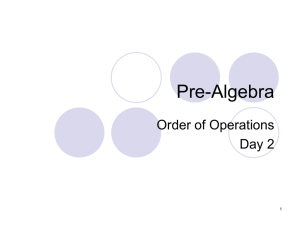
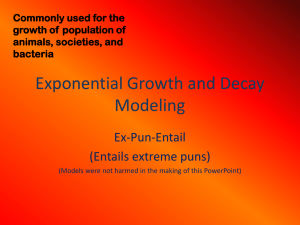
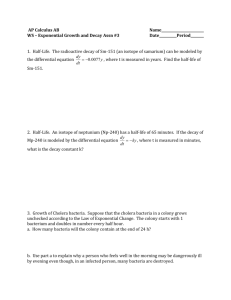

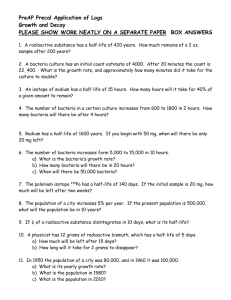

![저기요[jeo-gi-yo] - WordPress.com](http://s2.studylib.net/store/data/005572742_1-676dcc06fe6d6aaa8f3ba5da35df9fe7-300x300.png)
